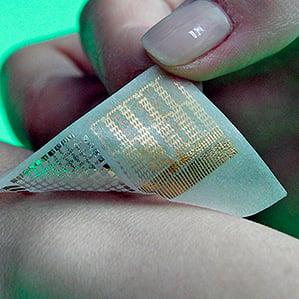A Bandage That Senses Tremors, Delivers Drugs, and Keeps a Record
Offering a preview of what future wearable medical devices may look like, researchers in Korea have built a skin patch that’s thinner than a sheet of paper and can detect subtle tremors, release drugs stored inside nanoparticles on-demand, and record all of this activity for review later.

While still under development, the technology might someday be useful to sufferers of Parkinson’s disease or other movement disorders. “The system represents a new direction in personalized health care that will eventually enable advanced diagnostics and therapy on devices that can be worn like a child’s temporary tattoo,” says Dae-Hyeong Kim, assistant professor of chemical and biological engineering at Seoul National University, who led the work (see “Innovators Under 35: Dae-Hyeong Kim”).
The work was done with researchers at MC10, a startup in Cambridge, Massachusetts, that is working on commercializing the underlying “stretchable electronics.” MC10, which has investments from big medical device companies including Medtronic, is working with partners in the pharmaceutical and medical device industries to launch products that would do part of what the Korean group demonstrated: detect and store signals like tremors, respiration, heart rate, and temperature so that doctors can review data about neuromuscular and cardiovascular disorders.
“Existing classes of electronics are rigid and packaged, leading to bulky strap-on monitors; the new technology would be unobtrusive and practically unnoticed by the wearer, says Roozbeh Ghaffari, cofounder of MC10 (see “Innovators Under 35: Roozbeh Ghaffari”).
A paper released on Sunday in Nature Nanotechnology describes multiple nanoscale membranes packaged as a system for motion sensing, drug delivery, and data storage—all of it integrated on a stretchable patch, like a Band-Aid, that would adhere on the skin. Drug therapy tests on human patients are still a few years off; so far, the group has demonstrated how it can release a dye on a patch of pig skin.
Spring-like strain gauges measure muscle activity. These consist of silicon nanomembrane sensors in a serpentine shape, each curve several hundred micrometers apart. When stretched, changes in electrical resistance on the filaments are detected, and the frequency of the signals indicates whether a stretch was from a normal arm movement or a fast tremor.
The data is recorded on a simple memory system, consisting of memory cells just 30 nanometers thick; these cells record high resistance versus low resistance states due to changing electrical properties across the membranes. In the future, these data could be accessed through an RFID tag integrated into the device, or might be streamed to a nearby smartphone; however, the communications component has not yet been added.
The patch also contains heating elements that can be activated remotely to release drugs. The heating elements raise the patch temperature several degrees, which in turn releases drugs surrounded by porous silica nanoparticles. When heated, the physical bond between the drug and nanoparticles breaks, leading to a diffusion-driven release of molecules through the skin.
“Ultimately we will develop a fully automated system that incorporates these sensors and a memory- and drug-release mechanism together with a microcontroller to deliver automated drug release in an epidermal patch,” Ghaffari says.
While the prototype is focused on detecting movement disorders, other versions could sense things like perspiration, temperature, heart rate, or blood oxygen, and use those changes as a triggering mechanism for various therapies. The teams are working to bring this platform through regulatory and clinical studies.
The work builds on the fundamental research of John Rogers, a materials scientist at the University of Illinois. Three years ago, he introduced the idea of “epidermal electronics,” or ultrathin, skin-like semiconductor materials that could monitor vital signs on the skin.
“What this paper does is take the epidermal electronics and couple it with memory onboard, and therapy. You can close the loop from diagnosis to therapy on a single patch,” Ghaffari says.
Other researchers have demonstrated competing approaches. For example, a beneath-the-skin drug-release chip is being developed commercially by MicroChips of Lexington, Massachusetts. That company was cofounded by Robert Langer, a biomedical engineer at MIT.
Keep Reading
Most Popular
Large language models can do jaw-dropping things. But nobody knows exactly why.
And that's a problem. Figuring it out is one of the biggest scientific puzzles of our time and a crucial step towards controlling more powerful future models.
The problem with plug-in hybrids? Their drivers.
Plug-in hybrids are often sold as a transition to EVs, but new data from Europe shows we’re still underestimating the emissions they produce.
How scientists traced a mysterious covid case back to six toilets
When wastewater surveillance turns into a hunt for a single infected individual, the ethics get tricky.
Google DeepMind’s new generative model makes Super Mario–like games from scratch
Genie learns how to control games by watching hours and hours of video. It could help train next-gen robots too.
Stay connected
Get the latest updates from
MIT Technology Review
Discover special offers, top stories, upcoming events, and more.